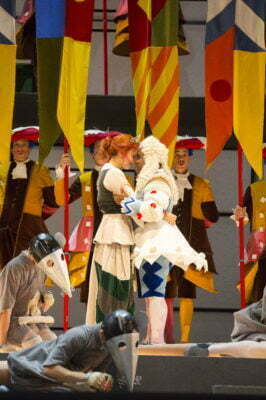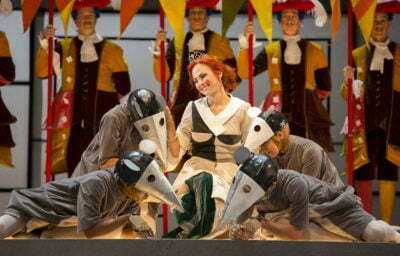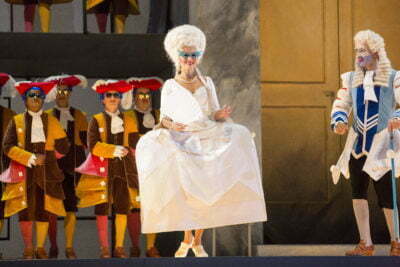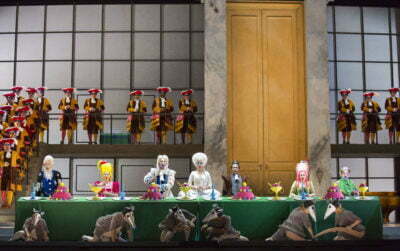Cinderella (La Cenerentola)
Music by Gioachino Rossini

Libretto by Jacopo Ferretti
Directed by Joan Font
Conducted by Sir Andrew Davis
Produced by Lyric Opera of Chicago
Rollicking Music with a Dramatic Flavor is Opera at its Best
It’s a fun time to be an opera fan. Later this season, the Lyric Opera of Chicago will perform Alban Berg’s Wozzek, Charles Gounod’s Romeo and Juliet, and the world premiere of Bel Canto, based on the novel by Ann Patchett. But for now, they are running two beloved comedies: Mozart’s The Marriage of Figaro and Gioachino Rossini’s La Cenerentola, which the Lyric is billing as Cinderella. Tragedy tomorrow, comedy tonight, as the Sondheim song goes, which is a particularly welcome change of pace after a season that included Don Giovanni, Il Trovatore, Porgy and Bess, Anna Bolena, Tosca, and ended with The Passenger, which is about Auschwitz. La Cenerentola originally premiered in 1817, only a year after Rossini’s best known work, The Barber of Seville, and sounds very similar. Quick and jaunty, Rossini’s music is three hours of pure delight, and this new-to-Chicago production, which was originally directed by Barcelonan Joan Font, captures all of Rossini and librettist Jacopo Ferretti’s humor, with just enough drama to make a satisfying fairy tale.

You know the plot of Cinderella; Rossini’s main innovations were to change the evil stepmother to a stepfather, and introduce a mistaken identity plot, which we soon see the reasons for. Mezzo-soprano Isabel Leonard plays Angelina, the young woman who is degraded and called “Cenerentola” by her wicked stepsisters and widower stepfather, who squandered her inheritance. Oddly, it’s Angelina who has the most serious songs, including the early “Una volta c’era un re,” which in Leonard’s interpretation, is quite dark and haunting. Although that’s partly because of the cone-faced mice surrounding her, which look like they came from The Nutcracker. Late in the show, Leonard is allowed to join with the rest of the cast’s rousing “Non piu mesta,” and it’s a stronger moment for having been set up so well as the conclusion of her character arc. Leonard’s Angelina does not seem to mind the drudgery so much, she cleans and folds laundry without any hint of resentment, but disrespect for honest work she cannot abide.

Alessandro Corbelli plays Don Magnifico, the story’s villain. He is hilarious. Don Magnifico makes his appearance with the aria “Miei rampolli femminini,” a rapid-fire recounting of a dream he had in which he was a flying donkey, and is so confident it’s a good omen, he shushes his daughters with clicking noises. Fans of The Barber of Seville will notice its similarity to another of Rossini’s bass arias, “La Calunnia,” and after watching Corbelli in this role, I would love to see him play Basilio. However, Don Magnifico allows him to be onstage much more, and to share several comic scenes with his nemesis, Dandini, played by baritone Vito Priante. Dandini is the valet of the prince, but to test the people’s hearts, the two have switched places. Going about in his master’s guise allows Dandini to match even Don Magnifico in pomposity, as shown in his up-tempo aria “Come un’ape ne’ giorni d’aprili,” in which he explains how “he” is required to marry. There are several moments of physical comedy between the two, and they play off each other brilliantly.

 Tenor Lawrence Brownlee is the real prince, Don Ramiro, who wins Cinderella’s heart while she believes he is a mere servant, and not even of noble birth, as she is. Brownlee shows off his coloratura in the dramatic Act II aria “Si, ritrovarla io giuro,” and effectively communicates the emotional urgency of this song. This is especially impressive because in this staging Don Ramiro is often subjected to minor indignities by Dandini while posing as a valet, which winds up making him more sensitive to Angelina’s plight. As the court wizard Alidoro, who acts as Angelina’s fairy godmother, Christian Van Horn has the most dignified bass aria, “Lá del ciel nell’arcano profondo,” which returns us to the seriousness of the story after Don Magnifico and Dandini’s antics. Diane Newman and Annie Rosen round out the leads as the evil stepsisters, and seem every inch Don Magnifico’s daughters.
Tenor Lawrence Brownlee is the real prince, Don Ramiro, who wins Cinderella’s heart while she believes he is a mere servant, and not even of noble birth, as she is. Brownlee shows off his coloratura in the dramatic Act II aria “Si, ritrovarla io giuro,” and effectively communicates the emotional urgency of this song. This is especially impressive because in this staging Don Ramiro is often subjected to minor indignities by Dandini while posing as a valet, which winds up making him more sensitive to Angelina’s plight. As the court wizard Alidoro, who acts as Angelina’s fairy godmother, Christian Van Horn has the most dignified bass aria, “Lá del ciel nell’arcano profondo,” which returns us to the seriousness of the story after Don Magnifico and Dandini’s antics. Diane Newman and Annie Rosen round out the leads as the evil stepsisters, and seem every inch Don Magnifico’s daughters.

Joan Font’s production is remarkable for balancing the darkness and comedy in the Cinderella story and Rossini’s music. The aesthetic of Joan Guillén’s set and costumes and Sarah Hatten’s wigs and makeup looks inspired by clowns and commedia dell’arte. The chorus of men with Simpsons-like painted yellow skin and blue hair is quite striking, and even the huge, pointy rats grew on me after my initial surprise. Since the set is nearly blank, lighting designer Albert Faura provided a sense of location with lush lighting for the ball and wedding, and allowed the bright costumes to illuminate themselves in Don Magnifico’s unhappy (but very clean) home. Font also used many staging devices like shadow-puppets and mirrors, but I won’t give them all away. La Cenerentola provides a work-out for conductor Sir Andrew Davis, who has to keep the fast-paced music flying, while allowing for comedic timing and respecting every syllable. He did so superbly, and Ferretti’s libretto was able to demonstrate what a fun language Italian is to sing in. Many people brought children to the opening performance, and that worried me, at first. But the production is so delightful, and Rossini’s reworking of the story made it so much sweeter, that the time flew by. For a mature child of reasonable age, La Cenerentola is a wonderful introduction to opera, and for anyone else, as well.

Highly Recommended
Jacob Davis
Playing at the Civic Opera House, 20 N Upper Wacker Drive, Chicago. To order tickets, call 312-827-5600 or visit lyricopera.org. Performances are October 7, 10, 13, 17, 23, and 26 at 7:30 pm, and October 30 at 2:00 pm. Running time is three hours and fifteen minutes, with one intermission.
